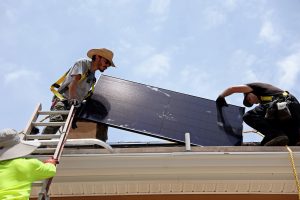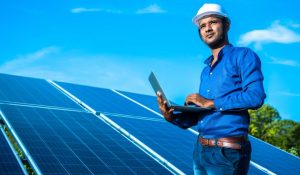The growth of solar energy in the United States may slow down sharply
US solar capacity growth is on track to hit a record. In the second quarter alone, the number of new solar installations increased by 45% compared to the same period last year.
However, there is a disturbing fact. The decline in solar energy prices since 2019 has flattened out.
This suggests that opportunities for further cost reduction in this sector may be exhausted. In fact, a Department of Energy study found that the US could generate up to 45% of its electricity from solar farms.
“The study highlights the fact that solar power, our cheapest and fastest growing source of clean energy, can produce enough electricity to power every home in the US by 2035,” said Secretary of Energy Jennifer Granholm.
According to the forecasts of the Ministry of Energy, this goal will require the commissioning of solar power plants with a total capacity of 1,050 GW to 1,570 GW. This is more than the combined capacity of all US generation at the moment, and 1450% more than all the solar generation available in the US.
Meanwhile, according to experts, an increase in the capacity of solar energy in the United States from the current 103 GW to the targets of the Department of Energy from 10.2 to 11.5 million acres of land. Moreover, environmental activists argue that the land occupied by solar farms will be useless for other purposes.
Developers are already delaying the completion of projects due to the increase in their cost. If this continues, many projects may be delayed. The Wood Mac and SEIA report notes that government support remains extremely important. But how can it be counted on for further injections into solar energy if there is no unity on this issue even among Democrats in Congress?

Named a serious threat to US solar energy
MOSCOW, 28 Sept. The Solar Energy Producers Association called the increase in tariffs a “threat to the industry.” Of these countries, the US supplies 80% of products for photovoltaic systems.
A decrease in the production of solar installations could harm the plans of US President Joe Biden. More Kenyans are turning to solar energy every year. What is the reason, understood the Institute for the Development of Technologies in the Fuel and Energy Complex (IRTTEK).
Life in the dark
About 8.1 million Kenyans live without electricity (Kenya’s population is 52 million as of 2019). 92% of the rural population uses wood fuel for cooking, which negatively affects their health.
The government has repeatedly tried to take measures to remedy the situation. Admittedly, quite successfully: for example, in July 2021, solar panels were exempted from VAT. This has been a breath of fresh air for Kenyan citizens, especially for low-income rural communities that remain out of reach of the national grid.
The move turned out to be beneficial for the authorities as well. Budget analysis showed that the benefits of exempting panels from VAT exceeded the forgone tax revenue by 7 or more times. Public investment has paid off handsomely. Also, the Kenyan government has abolished import duties on panels.
Changes in legislation
The increase in the number of solar power plants has necessitated changes in energy legislation.
These regulations were meant to protect the consumer from low quality solar products and poorly trained or unskilled technicians.

By law, all persons designing and installing solar photovoltaic systems, all manufacturers, sellers, distributors and contractors of solar photovoltaic systems must have a special license.
It is worth noting that Kenya imports more than 90% of the solar equipment used in the country due to the lack of local production technologies and capacities.
Private farms
One of the key players in the growth of the solar energy sector in Kenya is the private sector. More than 200,000 rural households have already connected to home solar systems. A high level of coverage was achieved due to the availability of products. Not only in terms of money, there are more than 800 outlets in rural areas that sell solar panels.
Solar panels have changed the lives of rural communities in Kenya by providing clean drinking water and lighting. Civilization has come to the poorest Kenyan villages. The advent of solar panels helped to improve the level of sanitation, increased the effectiveness of the fight against various diseases, which will undoubtedly indirectly affect not only Kenya, but also other regions of Africa.
In the past, some Kenyan villagers traveled several kilometers to fetch water. We stood in long lines and could spend a whole day getting water. The lack of water affected the epidemiological situation, of course, negatively.
However, everything changed with the commissioning of solar-powered water pumps. The 2.2 kilowatt pump guarantees operation even in low sunlight levels. It currently serves 700 households in seven local villages. The case when a real industrial revolution takes place at the local level with the help of new trends in energy.
The private sector is looking at solar power as a business opportunity. Solar systems, including lamps and chargers, play an important role in expanding the economic opportunities of farms. Now you can do business until late at night developing your business. Farmers can now charge their phones and use online payment platforms.
Farmers are increasingly using solar irrigation systems. Previously, irrigation farming was only available to the wealthy. Solar energy has improved the lives of poor farmers.